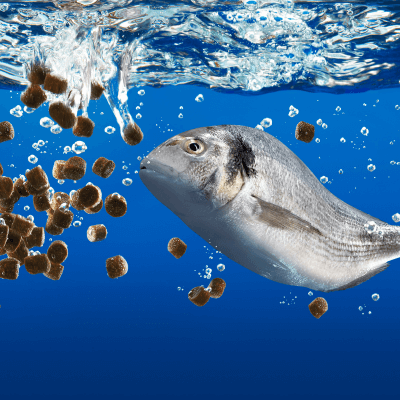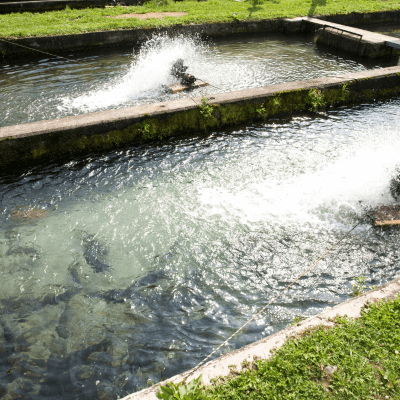Table of Contents
Fish diseases can pose serious challenges for aquarists and fish farmers, threatening the health of aquatic life and the stability of ecosystems in tanks or aquaculture systems. From bacterial infections like fin rot to systemic issues like dropsy, untreated illnesses can quickly escalate, leading to significant losses. To address these challenges, antibiotics play a crucial role in maintaining the health of fish and preventing the spread of diseases.
Among the many antibiotics used in aquaculture, ciprofloxacin stands out as a powerful tool. Known for its broad-spectrum activity, ciprofloxacin is highly effective against various bacterial pathogens, making it a go-to solution for fish health management. Its ability to target and eliminate harmful bacteria without harming the fish makes it an invaluable resource for aquarists and fish farmers alike.
In this blog post, we’ll dive deep into the world of fish ciprofloxacin. You’ll learn how it works, the common diseases it treats, and the best practices for its safe and effective use. We’ll also explore its benefits, potential risks, and essential tips for using it to keep your fish healthy and thriving.
Key Takeaways
- Effectiveness of Ciprofloxacin: Ciprofloxacin is a potent broad-spectrum antibiotic widely used to treat bacterial infections in fish, including fin rot, dropsy, and columnaris.
- Proper Usage is Crucial: Accurate dosing and appropriate application methods (via water or food) are essential to ensure the medication’s effectiveness while minimizing risks to fish and the aquarium ecosystem.
- Preventative Measures Matter: Maintaining clean water, providing a nutritious diet, and reducing stress in your tank are key to preventing bacterial infections and reducing the need for antibiotics.
- Risks of Overuse: Misuse or overuse of ciprofloxacin can lead to antibiotic resistance, disrupt the nitrogen cycle in aquariums, and harm beneficial bacteria.
- Consulting Experts: For severe or recurring infections, seeking advice from a veterinarian or aquatic health specialist is the best course of action to ensure the safety and health of your fish.
What Is Fish Ciprofloxacin and How Does It Work?
Definition: What Is Ciprofloxacin?
Ciprofloxacin is a broad-spectrum antibiotic belonging to the fluoroquinolone class of drugs. It is widely used in aquaculture and among aquarists to treat bacterial infections in fish. This powerful medication is specifically designed to combat harmful bacteria that can cause severe health issues in both ornamental and farmed fish species. Its versatility and effectiveness have made it a trusted solution for managing fish diseases.
Mechanism of Action: How It Fights Bacterial Infections in Fish
Ciprofloxacin inhibits bacterial DNA gyrase and topoisomerase IV, enzymes crucial for DNA replication, transcription, and repair in bacteria. By disrupting these vital processes, it stops bacterial growth and reproduction, ultimately eliminating the infection. This precise action targets harmful bacteria while maintaining the natural balance of the aquarium or pond environment.
Targeted Pathogens: Common Bacterial Infections Treated by Ciprofloxacin
Ciprofloxacin is highly effective against a wide range of gram-negative and some gram-positive bacteria. It is commonly used to treat infections caused by:
- Aeromonas: Known for causing ulcers, fin rot, and hemorrhagic septicemia in fish.
- Pseudomonas: A culprit behind fin erosion, skin ulcers, and systemic infections.
- Vibrio: Associated with vibriosis, a condition affecting marine fish species.
- Flexibacter (Columnaris Disease): Causes characteristic cotton-like lesions on the skin and gills.
By targeting these pathogens, ciprofloxacin helps restore fish health and prevent disease outbreaks in aquariums and aquaculture systems. However, proper diagnosis and usage are essential to ensure its effectiveness and avoid resistance.
Common Fish Diseases Treated with Ciprofloxacin
Fin Rot: Causes, Symptoms, and How Ciprofloxacin Helps
Fin rot is a common and often distressing disease that affects the fins of fish, causing them to fray, degrade, or become ragged. This condition is typically caused by bacterial infections from strains such as Aeromonas or Pseudomonas, often exacerbated by poor water quality, stress, or injury. Symptoms include discoloration, ragged edges, and in severe cases, complete fin loss.
Ciprofloxacin helps combat fin rot by directly targeting the underlying bacterial pathogens. By inhibiting bacterial DNA replication, ciprofloxacin prevents the infection from spreading and promotes recovery, leading to the regrowth of damaged fins when used correctly. Proper water management alongside antibiotic treatment enhances healing and prevents recurrence.
Dropsy: Understanding the Condition and Treatment Options
Dropsy is a condition characterized by severe bloating, raised scales (pinecone appearance), and organ failure in fish. It is often the result of internal bacterial infections but can also stem from poor water conditions, kidney dysfunction, or other systemic issues. Symptoms include a swollen abdomen, lethargy, and difficulty swimming.
Treating dropsy with ciprofloxacin involves administering the antibiotic through medicated food or adding it to the water column. Ciprofloxacin’s broad-spectrum action can tackle the internal bacterial infections that commonly cause dropsy. While it is most effective in the early stages, comprehensive care that includes improving water quality and reducing stressors is vital to successful treatment.
Columnaris Disease: Symptoms and Ciprofloxacin Effectiveness
Columnaris disease is caused by the bacterium Flavobacterium columnare and is often mistaken for fungal infections due to its cotton-like lesions. This disease affects the gills, skin, and mouth areas of fish and is particularly common in warm water. Symptoms include grayish-white spots on the skin, gill damage, mouth ulcers, and fin erosion.
Ciprofloxacin is effective in treating columnaris when administered promptly, as it disrupts the bacterial growth cycle and reduces the severity of infections. While ciprofloxacin works well to eliminate the bacteria, temperature control and improved water conditions are crucial to prevent the disease from recurring or becoming chronic.
By targeting these common diseases, ciprofloxacin provides aquarists with a reliable tool to safeguard their fish’s health.
How to Use Ciprofloxacin for Fish: Dosage and Guidelines
Dosage Instructions: Recommended Ciprofloxacin Dosage for Fish
The appropriate dosage of ciprofloxacin depends on the severity of the infection and the method of administration. A general guideline is:
- For water treatment: Use 10–20 mg of ciprofloxacin per liter of aquarium water. This ensures the medication reaches all fish in the tank.
- For medicated food: Mix 250 mg of ciprofloxacin with 1–2 tablespoons of fish food. Feed the medicated food once or twice daily for 5–7 days, or as directed by a veterinarian.


Always consult a fish health expert for precise dosage recommendations tailored to your aquarium’s size and fish species.
Application Methods: Mixing with Food or Adding to Water
Ciprofloxacin can be administered in two main ways, depending on the type of infection:
- Mixing with Food: Ideal for treating internal infections. Dissolve the recommended dose of ciprofloxacin in a small amount of water, then soak fish food pellets or flakes in the solution. Allow the food to dry slightly before feeding it to the fish.
- Adding to Water: Effective for treating external infections like fin rot or skin ulcers. Dissolve ciprofloxacin directly into the tank water, ensuring even distribution. Monitor water parameters carefully during treatment to prevent additional stress on the fish.
Precautions: Avoiding Overuse and Resistance Issues
While ciprofloxacin is highly effective, misuse or overuse can lead to serious consequences:
- Antibiotic Resistance: Overusing ciprofloxacin can contribute to bacterial resistance, making future treatments less effective. Use only when necessary and complete the full course of treatment.
- Water Quality Impact: Ciprofloxacin can affect beneficial bacteria in your tank, disrupting the nitrogen cycle. Perform water tests frequently and consider post-treatment water changes to restore balance.
- Consultation is Key: Always seek professional advice if you’re unsure about dosing or treatment. Improper use can harm both fish and the aquarium ecosystem.
By following these dosage guidelines and precautions, you can ensure that ciprofloxacin is used safely and effectively to treat fish diseases.
Benefits and Risks of Using Fish Ciprofloxacin
Benefits: Effective Treatment, Ease of Use, Broad-Spectrum Action
Ciprofloxacin offers several advantages for treating bacterial infections in fish:
- Effective Treatment: With its strong efficacy against a broad spectrum of gram-negative and certain gram-positive bacteria, it is a dependable option for treating conditions such as fin rot, columnaris, and dropsy.
- Ease of Use: Ciprofloxacin is versatile, with the option to administer it through food or water, making it convenient for treating various types of infections.
- Broad-Spectrum Action: It targets multiple types of harmful bacteria, providing comprehensive coverage against many common pathogens in aquariums and aquaculture systems.
These benefits make ciprofloxacin a trusted option for aquarists looking to safeguard their fish’s health quickly and effectively.
Risks: Potential Antibiotic Resistance, Impact on Aquarium Ecosystems
While ciprofloxacin is highly effective, its use comes with potential risks:
- Antibiotic Resistance: Overuse or improper dosing of ciprofloxacin can lead to the development of antibiotic-resistant bacteria. This not only reduces the effectiveness of future treatments but also poses broader environmental concerns.
- Impact on Aquarium Ecosystems: Ciprofloxacin may harm beneficial bacteria in the tank, disrupting the nitrogen cycle and leading to ammonia or nitrite spikes. This can stress fish and negatively affect water quality.
- Side Effects on Fish: In rare cases, fish may exhibit adverse reactions, including loss of appetite or lethargy, particularly if the medication is over-administered.
To minimize these risks, it’s essential to use ciprofloxacin responsibly and in consultation with a fish health expert.
Alternatives: Other Treatment Options for Bacterial Infections
If ciprofloxacin isn’t suitable or available, several alternatives can be considered for treating bacterial infections in fish:
- Kanamycin: Another broad-spectrum antibiotic effective against gram-negative bacteria.
- Oxytetracycline: Commonly used in aquaculture for external and internal infections.
- Salt Baths: Effective for mild bacterial infections or as a supplementary treatment.
- Improved Water Quality: Often, bacterial infections can be prevented or mitigated by maintaining optimal water parameters and reducing stressors.
Each alternative has its pros and cons, and the choice depends on the specific disease, fish species, and aquarium conditions. Consulting with a veterinarian or aquarist specialist can help determine the best approach.
By understanding both the benefits and risks of ciprofloxacin, as well as available alternatives, you can make informed decisions to keep your fish healthy while maintaining a balanced aquarium
Tips for Safely Treating Fish Diseases with Ciprofloxacin
Monitor Symptoms: Identifying Signs That Your Fish Need Treatment
The first step in treating fish diseases is correctly identifying when treatment is necessary. Look for the following symptoms to determine if your fish might need ciprofloxacin:
- Physical Signs: Ragged fins, ulcers, swelling, or discoloration.
- Behavioral Changes: Lethargy, loss of appetite, or abnormal swimming patterns.
- Advanced Symptoms: Raised scales (dropsy), cotton-like lesions (columnaris), or rapid gill movement.
Early detection is critical for effective treatment. Overuse of ciprofloxacin without clear symptoms can harm the ecosystem and contribute to antibiotic resistance.
Proper Water Maintenance: Ensuring Clean Water During Treatment
Maintaining clean water is vital for successful treatment and recovery:
- Water Quality Testing: Regularly test ammonia, nitrite, and nitrate levels. High levels of these compounds can stress fish and hinder the effectiveness of ciprofloxacin.
- Filtration Management: Remove activated carbon from filters during treatment, as it can absorb the antibiotic and reduce its efficacy.
- Temperature and Oxygen Levels: Keep the water temperature and oxygen levels within the optimal range for your fish species to reduce stress and aid recovery.
Clean water not only supports the medication’s effectiveness but also helps create a healthier environment for your fish.
Post-Treatment Care: Steps to Prevent Recurrence of Infections
After completing the ciprofloxacin treatment, follow these steps to ensure your fish remain healthy and prevent future outbreaks:
- Perform Water Changes: Remove any residual medication from the tank by performing partial water changes and reintroducing activated carbon to the filter.
- Rebalance Beneficial Bacteria: Consider using a bacterial supplement to restore the aquarium’s biological balance, as ciprofloxacin may disrupt beneficial bacteria.
- Monitor Fish Health: Continue observing your fish for signs of recovery or recurring symptoms. Prompt action can prevent new infections.
- Preventative Measures: Maintain optimal water quality, provide a nutritious diet, and reduce stress by avoiding overcrowding or sudden environmental changes.
By carefully monitoring your fish, maintaining a clean habitat, and providing proper post-treatment care, you can maximize the effectiveness of ciprofloxacin while ensuring long-term health for your aquatic pets.
Conclusion
Ciprofloxacin is an incredibly effective tool for treating a wide range of bacterial infections in fish, from fin rot to more severe conditions like dropsy and columnaris disease. Its broad-spectrum action, ease of use, and reliable results make it a go-to antibiotic for aquarists and fish farmers seeking to restore and maintain the health of their aquatic life.
However, its effectiveness relies heavily on proper usage and precautions. Overusing or misapplying ciprofloxacin can lead to antibiotic resistance, disrupt the aquarium ecosystem, and diminish its long-term efficacy. Following dosage guidelines, maintaining water quality, and carefully monitoring your fish’s symptoms are crucial steps in ensuring successful treatment.
For severe or recurring infections, it’s always best to consult a veterinarian or aquatic health expert. Their guidance can help you choose the most appropriate treatment plan while safeguarding the health of your fish and their environment. With responsible use, ciprofloxacin can help you keep your fish healthy and thriving in a balanced and harmonious aquatic ecosystem.
References
- Nouws JF, Grondel JL, Schutte AR, Laurensen J. Pharmacokinetics of ciprofloxacin in carp, African catfish and rainbow trout. Vet Q. 1988 Jul;10(3):211-6. https://doi.org/10.1080/01652176.1988.9694173.
- Busari AA, Efejene IO, Olayemi SO, Orororo OC, Egbune EO. Evaluation of antibiotic use and analysis of ciprofloxacin and gentamicin residue in fish samples from farms in Lagos, Nigeria. Environ Monit Assess. 2024 Jan 9;196(2):127. doi: 10.1007/s10661-024-12303-z.
- Haizea Ziarrusta, Leire Mijangos, Mireia Irazola, Ailette Prieto, Nestor Etxebarria, Eneritz Anakabe, Maitane Olivares, Olatz Zuloaga, Ciprofloxacin by-products in seawater environment in the presence and absence of gilt-head bream, Chemosphere, Volume 197, April 2018, Pages 560-568. https://doi.org/10.1016/j.chemosphere.2018.01.069.
FAQ: Fish Ciprofloxacin
1. What is fish ciprofloxacin?
Fish ciprofloxacin is a broad-spectrum antibiotic used to treat bacterial infections in fish. It works by targeting the DNA replication process of harmful bacteria, effectively halting their growth and eliminating infections.
2. What types of fish diseases can ciprofloxacin treat?
Ciprofloxacin is effective against bacterial infections such as:
- Fin rot
- Dropsy
- Columnaris disease
- Skin ulcers
- Hemorrhagic septicemia
3. How do I administer ciprofloxacin to my fish?
Ciprofloxacin can be administered in two main ways:
- In water: Dissolve the recommended dose in the aquarium water to treat external infections.
- In food: Soak fish food in a ciprofloxacin solution to treat internal infections.
4. What is the correct dosage for ciprofloxacin?
A general guideline is:
- For water treatment: 10–20 mg per liter of water.
- For medicated food: 250 mg mixed with 1–2 tablespoons of food, given once or twice daily for 5–7 days.
Always consult an expert for specific dosing recommendations based on your fish species and tank size.
5. Can ciprofloxacin harm my aquarium?
Ciprofloxacin can disrupt beneficial bacteria in your aquarium, potentially affecting the nitrogen cycle. To minimize harm:
- Remove activated carbon from filters during treatment.
- Monitor water quality and perform water changes after treatment.
6. Are there any risks associated with using ciprofloxacin?
Yes, potential risks include:
- Development of antibiotic-resistant bacteria due to misuse.
- Harm to the aquarium ecosystem if overused.
- Stress or adverse reactions in fish if the dosage is incorrect.
7. How can I prevent diseases in my fish without antibiotics?
Preventative measures include:
- Maintaining excellent water quality.
- Providing a balanced diet.
- Reducing stress through proper tank conditions and avoiding overcrowding.
8. What should I do if the infection persists after treatment?
If the infection does not improve or recurs, consult a veterinarian or aquatic health expert. They can diagnose underlying issues and recommend alternative treatments.
9. Can ciprofloxacin treat fungal infections?
No, ciprofloxacin is an antibiotic and is only effective against bacterial infections. For fungal infections, antifungal treatments are required.
10. Is ciprofloxacin safe for all types of fish?
While ciprofloxacin is generally safe, some sensitive fish species may react differently. Always research your specific fish species and consult an expert if unsure.
